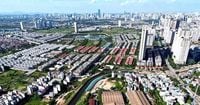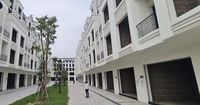As real estate prices in Hanoi's inner city continue to soar, a significant shift towards the suburbs is becoming increasingly evident. This trend, driven by a combination of high prices and limited land availability for new projects, is bolstered by well-planned infrastructure developments aimed at connecting suburban areas to the city center.
According to the Hanoi Capital Planning, the city is projected to have a permanent population of approximately 11 million by 2030, a substantial increase from the current 9 million. Additionally, the floating population is expected to reach 1.5 million, with the urbanization rate rising to 70%, up from the current 49%. These figures underscore the pressing need for new housing supply in the capital.
Ms. Do Thu Hang, Senior Director of the Research & Consulting Department at Savills Hanoi, noted that despite improvements in housing supply over recent quarters, it has yet to meet the burgeoning market demand. "The imbalance between supply and demand has led to a continuous rise in house prices in Hanoi's inner city," she stated.
According to Savills' records from the fourth quarter of 2024, the average secondary price for urban projects in Hanoi's inner city ranges from 190 to 450 million VND per square meter for land with houses. For villas and townhouses, prices fall between 160 and 270 million VND per square meter, while high-rise apartments average from 65 million VND per square meter to over 300 million VND.
These high price points have significantly impacted potential homebuyers, particularly those seeking affordable housing options. Even with bank loans or financial leverage considered, accessing homes in the inner city remains a daunting challenge. Consequently, many buyers are increasingly looking towards suburban markets.
Ms. Hang emphasized that the trend of relocating to suburban areas has become pronounced as land availability in the inner city shrinks. Areas near Ring Roads 2 and 3 are nearly devoid of land for further development. This shift is further encouraged by government policies aimed at reducing population density in the inner city.
The overarching goal outlined in the Hanoi Capital General Planning until 2045, with a vision extending to 2065, is to transform Hanoi into a modern, smart, green, and sustainable city. To achieve this, the city is adjusting its urban development strategies, particularly through policies that promote population dispersal from the inner city to alleviate infrastructure pressure and redistribute residential density.
Key conservation areas such as the Old Quarter, Hoan Kiem Lake, Ba Dinh, West Lake, and the Thang Long Imperial Citadel will see efforts to relocate residents to enhance these areas for tourism, commerce, and cultural purposes. Concurrently, the central urban area is set to expand westward and southward, linking with the upcoming Urban Corridor of Ring Road 4 and extending north towards Soc Son.
To realize the goal of population dispersal, Hanoi is investing heavily in the transportation, technical, and social infrastructure of suburban areas. Three main regions are focused on development: the West and South, and the East and North of the Red River. These areas are being methodically planned according to their specific functions and are all being developed under the Transit-Oriented Development (TOD) model, which emphasizes public transport accessibility.
The construction of Ring Roads 3.5 and 4 is expected to play a crucial role in facilitating convenient connections from suburban areas to the city center, thereby enhancing the demand for housing in these regions. Major urban projects in the suburbs, such as those in Dong Anh, Me Linh, Thuong Tin, and Long Bien, are also witnessing significant interest.
Dong Anh is leading the way with 84% of primary transactions, equating to 2,799 units sold. Following closely are Me Linh and Thuong Tin, each representing 4% of transaction volume with approximately 140 units sold. This trend is not only appealing to residents but also attracting investors looking for opportunities in suburban real estate.
Ms. Huynh Thi Kim Thanh, Manager of the Investment Consulting Department at Savills Vietnam, remarked that developing transportation infrastructure and suburban urbanization is key to addressing the imbalance between supply and demand for residential properties. "As major transportation projects like ring roads, expressways, and public transit systems are prioritized, they will enhance connectivity between the city center and suburban areas," she explained.
This approach not only alleviates pressure on central areas but also fosters sustainable growth in satellite urban areas. Building a comprehensive infrastructure that includes schools, hospitals, commercial spaces, and green areas will significantly attract residents, thereby increasing demand for residential properties.
Experts also caution that while the potential for suburban development is substantial, challenges remain. The timeline for major projects can stretch over several years, and significant investment costs may strain budgets and inflate land prices. Additionally, speculation triggered by planning announcements can lead to property values exceeding their actual worth.
To mitigate risks when selecting housing projects linked to new infrastructure development, experts recommend that buyers carefully evaluate factors such as the progress of infrastructure, the capability and reputation of developers, and the transparency of project legality. This thorough consideration is essential for navigating the evolving real estate landscape in Hanoi.


